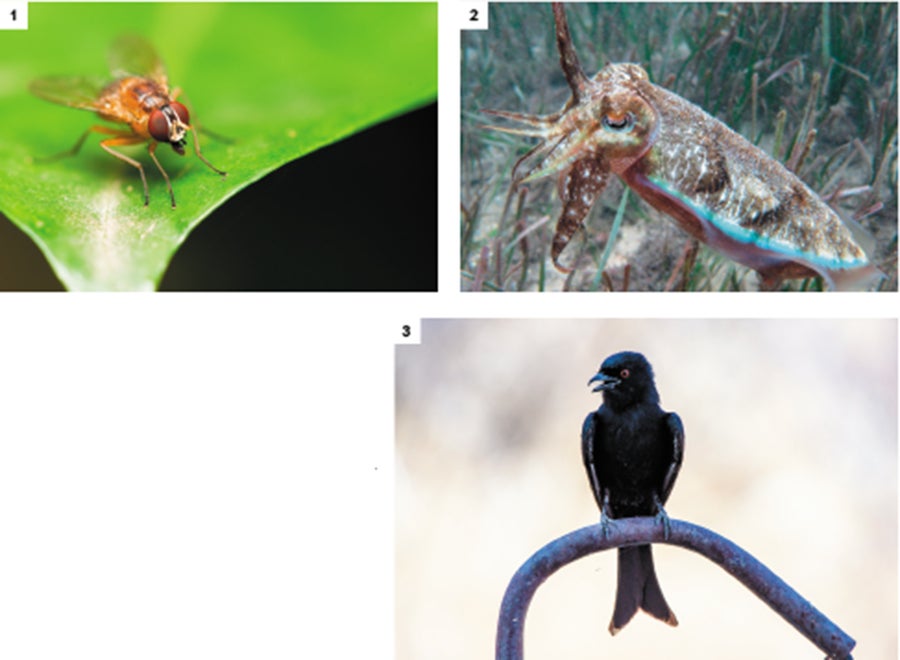The animal world seems to burst with sugar and spice these days. Evidence for cooperation and compassion among swimming, flying and walking creatures has captured public imagination. In the ocean, groupers, wrasse and eels form a multispecies team, working together to flush out and consume prey in bouts of collaborative hunting. In the sky, variegated fairy wrens and splendid fairy wrens recognize one another, form stable partnerships and jointly defend patches of eucalyptus scrubland. Among chickens, mother hens show empathetic distress when they see their chicks experience mild discomfort. Chimpanzees rush to console the loser of a fight, even when they themselves played no part in the altercation. And in an act of ultimate sacrifice, rats give up a chocolate reward to rescue companions made to tread water in a small pool.
For centuries scholars of animal behavior overemphasized the role of rivalry and violence among animals. The current focus on kindness and care is a necessary corrective to that long-standing view of nature as “red in tooth and claw,” as poet Alfred, Lord Tennyson put it. Yet even as we swoon over animal sweetness, there is a risk of that pendulum swinging too far and eclipsing part of the story. Many animals carry out disinformation campaigns aimed at others, within and across species. They mislead, cheat and lie in rampant acts of deception.
Intent to deceive
On supporting science journalism
If you're enjoying this article, consider supporting our award-winning journalism by subscribing. By purchasing a subscription you are helping to ensure the future of impactful stories about the discoveries and ideas shaping our world today.
Deception in nonhuman animals is defined as the sending out of false signals in an attempt to modify the behavior of another animal in ways that benefit the sender. Cuttlefish are masters of such disinformation. Relatives of the octopus, they have the ability to quickly change color, thanks to pigment-containing cells in their skin called chromatophores. Their powers of disguise can make mating a turbulent affair. In 2017 marine biologists led by Justine Allen of Brown University reported that they had observed a male common European cuttlefish approach a female as they scuba-dived in the Aegean Sea off Turkey. The female moved away with apparent indifference. The male camouflaged himself against the background for six minutes, leaving the female seemingly unaware of his continued presence. Then, suddenly, he lunged and grabbed her, and the two mated head to head.
In an Australian species called the mourning cuttlefish, deception goes beyond camouflage. When a male swims along between a female paramour on the left and a male competitor on the right, he displays two sets of signals containing polar-opposite information. From his left side he issues typical male courtship signals. On his right side, though, he emits the signals typical of a female. To his male competitor, then, this suitor appears to be just another female. Brilliant—and sneaky!
Biologist Culum Brown of Macquarie University in Sydney and his team call the mourning cuttlefish male’s double signaling “tactical deception” because it is deployed with forethought. It occurs in a specific context (when a male courts a female in the presence of a single rival male). Camouflage, mimicry and tactical deception are three key types of animal deception, with blurred boundaries between categories, as the cuttlefish examples illustrate. When attempts to mislead are carried out intentionally, whether through camouflage, mimicry or some other behavior, that is tactical deception.
As visual primates, we humans may be biased toward recognizing deception based on misdirection of images. Yet other senses, too, may be tricked. A highly vocal bird called the fork-tailed drongo, a resident of the Kalahari Desert in Africa, emits alarm calls on sighting predators. Sometimes this is honest signaling that benefits not only other drongos but also the birds’ neighbors: southern pied babblers and meerkats will dive for safety when they hear the drongo’s calls. But other times drongos do something not as honest, even downright obnoxious. For instance, if a drongo spots a meerkat in possession of a particularly winsome food item such as a plump gecko, the bird may call falsely—in the absence of any predators at all. On hearing the call, the meerkat drops the food and flees to safety. The drongo then scoops up and consumes the gecko. Zoologist Tom P. Flower, now at Capilano University in British Columbia, and his colleagues have found that this type of food thievery results in nearly a quarter of the biomass intake of drongos. Any opportunity to up one’s quota of stolen delicacies makes good evolutionary sense for these birds.
Drongos’ penchant for pretending does not end there, though. Truthful signaling is the norm in the animal world. Too much disinformation offered to the same audience, and the jig will be up because a deceiver’s social partners are likely to catch on. The “cry wolf” syndrome operates in other animals besides little boys, after all. Evolution has shaped the vocal repertoire of drongos accordingly: the birds have at least 51 different false alarms, which they vary during repeated food-theft attempts, according to Flower and his collaborators. In aiming to steal edibles from the same “targets” more than once, drongos change their alarm-call type nearly 75 percent of the time, and in a spectacular act of betrayal they often utter the alarm calls characteristic of their targets themselves. This strategic combination of vocal mimicry and tactical deception keeps the targets guessing, to the drongos’ advantage. Like cuttlefish, drongos intend to deceive. That is the hypothesis, at least. It is a reasonable notion because in both cases, false signals are broadcast not willy-nilly but only after thoughtful assessment of the animals’ dynamic social world.
Given our own evolved tendencies toward intentional deception, it is no surprise that our closest living relatives, monkeys and apes, are among the prime animal con artists. Primatologist Frans de Waal of Emory University has recounted a time when Yeroen, a chimpanzee at the Arnhem Zoo in the Netherlands, limped only in the presence of his great rival Nikkie, a fake hobbling apparently meant to gain sympathy. Systematic research on chimpanzees and many kinds of monkeys shows that these primates think up innovative ways to distract and mislead social partners when there is a mating or food prize at stake that they want for themselves.

Wild liars: The common fruit fly (top left), mourning cuttlefish (top right) and fork-tailed drongo (bottom) are among the many animals that have been found to deceive. Alongkot Sumritjearapol Getty Images (top left); S. Rohrlach Getty Images (top right); Trevor Platt Getty Images (bottom)
Unconscious hustling
But the intricacy, indeed the elegance, of animal deception does not depend on conscious intent. The magnificent spider of Australia hunts moths at night using a ball of sticky silk termed a bolas. This grandiosely named arachnid is white in color with varied markings across its body. Rather than spinning a web to catch prey, this spider produces a single strand of silk with a bolas at the end and flings the line at nearby moths. Here is the magnificently Machiavellian part: the bolas gives off a pheromone that mimics the scent of a female moth. Lured by the irresistible odor, male moths flutter close and become ensnared in the sticky silk. The spiders may gobble the moths right away or store them for a snack later on. Nothing about the spiders’ deception suggests a thought-out strategy. Instead evolution has promoted the behavior because it benefits their reproductive success.
The same mechanism explains deception in fruit flies. These insects are not shy about their cannibalistic tendencies—young larvae readily consume older or injured individuals. Yet they rarely slurp up fruit-fly eggs. Ecologist Sunitha Narasimha of the University of Lausanne in Switzerland and her team discovered why. It turns out a pheromone exuded by the fruit-fly mother seals the eggs, preventing telltale odors from leaking out, which in turn masks their identity from the tiny cannibals. It is a nifty way to disguise eggs in plain sight in a species not known for straight-up parental protection.
Sex and reproduction offer a ripe context for the sharing of false signals. Among birds, cuckoo females are famous for depositing their eggs into the nests of other females, then fleeing the scene. The nesting mothers are fooled into expending labor to care for offspring not their own. This behavior is widespread far beyond cuckoos. Called conspecific brood parasitism, meaning within-species cheating that deploys an egg as a freeloader in a nest, it is practiced by 200 bird species.
In some animals, the deception starts before any offspring are produced. Female brown trout sometimes quiver violently as though they are ready to lay eggs even when they are not. In a 2001 study of this startling behavior, Erik Petersson and Torbjörn Järvi, both then at the National Board of Fisheries in Sweden, called it “false orgasm.” In response, tricked males spew their sperm yet fertilize nothing at all. Why do the females spend this extra energy? They may just be discouraging unwanted males. Intriguingly, though, Petersson and Järvi found that the frequency of false orgasm went up as females neared the time of genuine spawning. So it could also be that females seek—and achieve—release of sperm from multiple males because doing so boosts the vigor of their offspring.
Domesticated liars
Even at our very own home and hearth, animals may deceive. Dogs are lauded for their supreme loyalty, yet the real picture is more complicated. Working with domestic dogs, ethologist Marianne Heberlein of the University of Zurich arranged for the dogs to interact with one of two women who either shared food with them (call her Ms. Cooperator) or failed to share and took the food herself (Ms. Competitor). The dogs could then lead these partners to a favored food, a nonfavored food or a location with no food. On day one, the dogs led Ms. Cooperator more often to the location with the preferred food. By day two, the dogs had acquired more knowledge about their situation. Now they led Ms. Competitor less often to the preferred-food location and inhibited their searching behavior toward the preferred food in her presence.
As anyone who has lived with dogs knows, they are not great at forgoing beloved foods. Apparently the dogs in this experiment wanted to increase their chances of getting the desirable food later—and knew that deceiving the selfish Ms. Competitor might just increase their odds. Maybe, too, Heberlein says, they just did not fancy the notion of a disliked human getting a treat. Whatever their motivation, the dogs’ deception was tactical.
What is the take-home lesson here? Be nice to dogs, and naturally, they will be nice to you. More broadly, animal duplicity may be carried out with awareness and sometimes even with emotional gusto. For this reason, we may see something of ourselves in the dogs or in cuttlefish who give off false signals in mating and birds who mislead to steal food. And yet across species—including those animals who deceive in the absence of premeditated intent—the same individuals may act honestly in some circumstances and connivingly in others. That Janus-headed nature may sound familiar to us, too.

